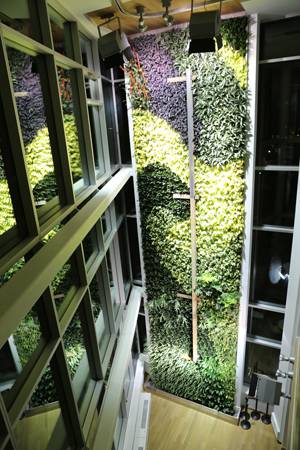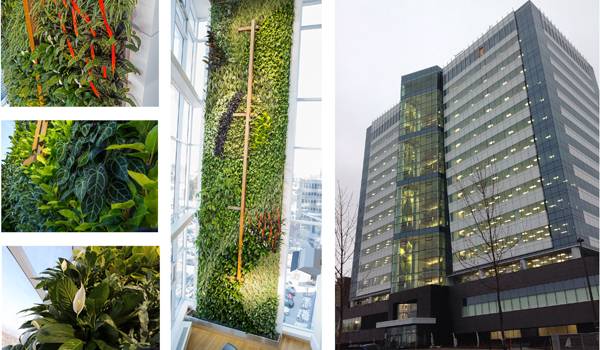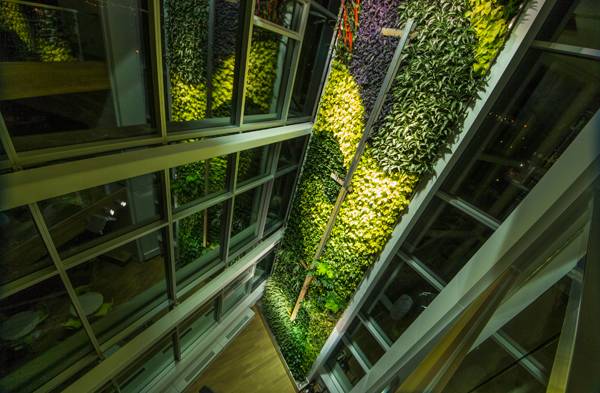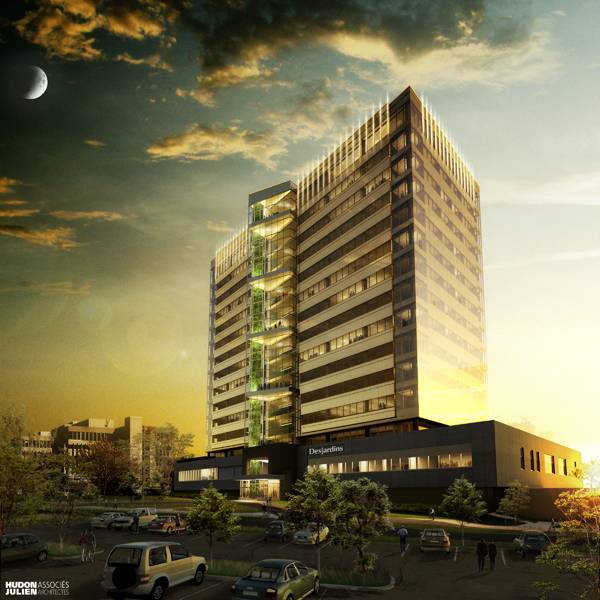Green over Grey design “The Currents”, the World’s tallest interior living wall! At 65 meters (213 feet), “The Currents,” the world’s tallest living green wall can be found in the Desjardins building in Quebec, Canada. This entirely hydroponic system on the north wall of the atrium improves the air and aesthetic qualities of the 15-story space. Designed by Green Over Grey, this is an example of their mission to create living works of art. The Currents: Inspiration

The first stage of the world’s tallest living green wall. Credit: www.greenovergrey.com / Jacques Côté, Desjardins
As the name suggest, “The Currents” installation was inspired by water, specifically the historical St. Lawrence River, which is very important to Quebec and can be seen from the Desjardins building. After observing the river, the flow of water, and the motion of the tributaries, chief designer for Green Over Grey, Mike Weinmaster, spent 5 months designing the artwork and selecting plants for the project.
The Plants The plants are installed in a completely soil-less hydroponics system made from 1.5 metric tons of recycled water bottles and plastic bags. In keeping with the theme of “The Currents,” the plants are arranged in swatches of greens, yellow, and purple with highlights of white, red, and orange flowering plants. Plant colors, textures, and sizes extenuate the intricate details of the artwork and create an overall aesthetic of ebb and flow. The overall goal of the installation is to improve the indoor air and aesthetic quality of the atrium for the 1,450 employees, and plants such as
philodendrons,
monsteras,
sanseviera, and scheffleras do exactly that. Elkhorn ferns, clusias, ginger, banana plants, and fig trees are just some of the 42 species of plants utilized in the project.

Planting the green wall. Credit: www.greenovergrey.com / Jacques Côté, Desjardins
Many microrganisms living around the plant roots thrive in such an environment and help break down toxins in the air. One noteworthy specimen is
Spathiphyllum ‘Mauno Loa,’ the peace lily, which according to the NASA Clean Air Study helps remove indoor air pollutants emitted by construction materials and photocopiers such as benzene, formaldehyde, and trichloroethylene. Peace lilies can survive in very low light conditions and have many applications at a variety of scales including purifying the air in an individual home.

Night time display. Credit: www.greenovergrey.com / Jacques Côté, Desjardins
Green Over Grey Living Walls and Design, based in Vancouver, B.C., was founded 10 years ago as a research project and specialized in the design of green walls in North America. They are noted for their installations in the Edmonton Airport, Vancouver’s Olympic Village, Microsoft headquarters in Washington, and now the world’s tallest living green wall in Quebec, Canada. They have revolutionized the green wall system with their soil-less design.

Worlds tallest green wall. Credit: www.greenovergrey.com / Jacques Côté, Desjardins
Instead of using small pockets of growing medium, which limits the design, and ultimately causes additional maintenance and upkeep problems, Green Over Grey utilizes a hydroponics system to keep the roots moist enough to grow without soil. A layer of moss along the entire wall is a natural solution to provide moisture and nutrients for the plants.
Patrick Poiraud, co-founder of Green over Grey states
“The wall is fully hydroponic (i.e. soil-free) and incorporates plants that thrive in similar vertical environments found in nature, such as on tree branches and next to waterfalls. The end result is a visually pleasing piece that provides cleaner indoor air and improves both the acoustic and the value of the property.” As Architects and Landscape Architects continue to collaborate in order to design beautiful, healthy, and safe environments for people both indoors and outdoors, this is certainly a leading example of how plants can improve our lives. The world’s tallest living green wall teaches designers to continue to look to nature for inspiration not only during the design phase but for the fabrication and installation processes as well.
Recommended reading: Planting Green Roofs and Living Walls by Nigel Dunnett
Gardening Vertically: 24 Ideas for Creating Your Own Green Walls by Noémie Vialard Article written by Rachel Kruse
Published in Blog











